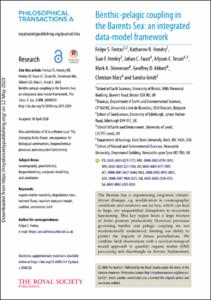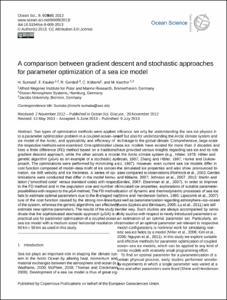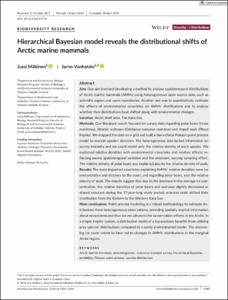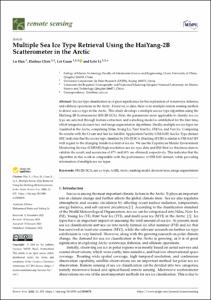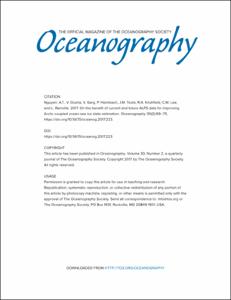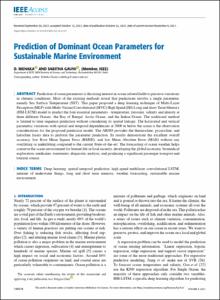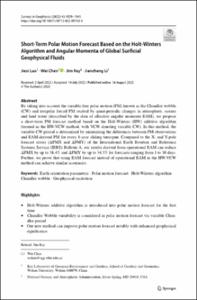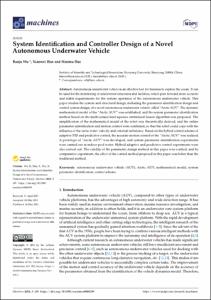Browsing CAPARDUS Practices by Subject "Data aggregation"
Now showing items 1-12 of 12
-
Benthic-pelagic coupling in the Barents Sea: an integrated data-model framework.
(2020)The Barents Sea is experiencing long-term climate-driven changes, e.g. modification in oceanographic conditions and extensive sea ice loss, which can lead to large, yet unquantified disruptions to ecosystem functioning. ... -
A comparison between gradient descent and stochastic approaches for parameter optimization of a sea ice model.
(2013)Two types of optimization methods were applied to a parameter optimization problem in a coupled ocean-sea ice model of the Arctic, and applicability and efficiency of the respective methods were examined. One optimization ... -
Hierarchical Bayesian model reveals the distributional shifts of Arctic marine mammals.
(2018)Our aim involved developing a method to analyse spatiotemporal distributions of Arctic marine mammals (AMMs) using heterogeneous open source data, such as scientific papers and open repositories. Another aim was to ... -
A method for evaluating operational implications of regulatory constraints on Arctic shipping.
(2022)Development of effective marine policy necessitates evidence-based, data-driven evaluations of the effects of regulatory constraints on operations. This is essential to better understand implications of policy decisions ... -
Multiple Sea Ice Type Retrieval Using the HaiYang-2B Scatterometer in the Arctic.
(2023)Sea ice type classification is of great significance for the exploration of waterways, fisheries, and offshore operations in the Arctic. However, to date, there is no multiple remote sensing method to detect sea ice type ... -
On the Benefit of Current and Future ALPS Data for Improving Arctic Coupled Ocean-Sea Ice State Estimation.
(2017)Autonomous and Lagrangian platforms and sensors (ALPS) have revolutionized the way the subsurface ocean is observed. The synergy between ALPS-based observations and coupled ocean-sea ice state and parameter estimation as ... -
Prediction of Dominant Ocean Parameters for Sustainable Marine Environment.
(2021)Prediction of ocean parameters is the rising interest in ocean-related fields to perceive variations in climatic conditions. Most of the existing methods reveal that predictions involve a single parameter, namely Sea Surface ... -
Sea ice assimilation into a coupled ocean-sea ice model using its adjoint.
(2017)Satellite sea ice concentrations (SICs), together with several ocean parameters, are assimilated into a regional Arctic coupled ocean-sea ice model covering the period of 2000-2008 using the adjoint method. There is ... -
Short-Term Polar Motion Forecast Based on the Holt-Winters Algorithm and Angular Momenta of Global Surficial Geophysical Fluids.
(2022)By taking into account the variable free polar motion (PM) known as the Chandler wobble (CW) and irregular forced PM excited by quasi-periodic changes in atmosphere, oceans and land water (described by the data of effective ... -
System Identification and Controller Design of a Novel Autonomous Underwater Vehicle.
(2021)Autonomous underwater vehicle is an effective tool for humans to explore the ocean. It can be used for the monitoring of underwater structures and facilities, which puts forward more accurate and stable requirements for ... -
Trait-based approaches in rapidly changing ecosystems: A roadmap to the future polar oceans.
(2018)Polar marine regions are facing rapid changes induced by climate change, with consequences for local faunal populations, but also for overall ecosystem functioning, goods and services. Yet given the complexity of polar ... -
Using modelled prey to predict the distribution of a highly mobile marine mammal.
(2020)Species distribution models (SDMs) are a widely used tool to estimate and map habitat suitability for wildlife populations. Most studies that model marine mammal density or distributions use oceanographic proxies for marine ...
 Repository of community practices in Ocean Research, Applications and Data/Information Management
Repository of community practices in Ocean Research, Applications and Data/Information Management
